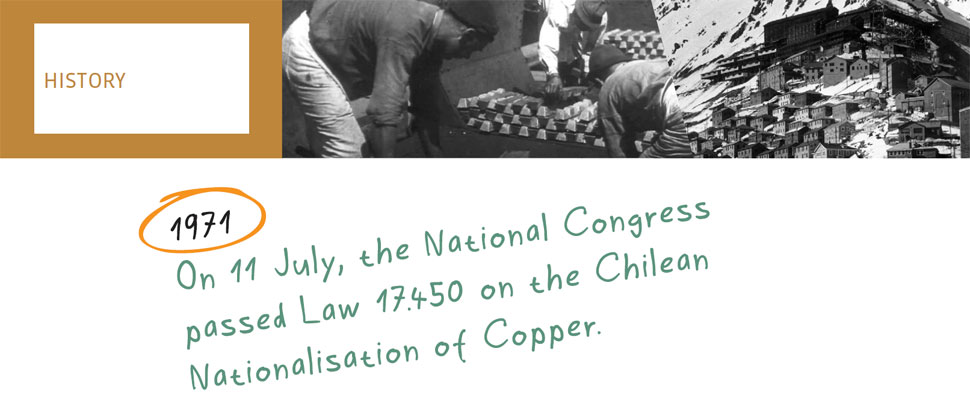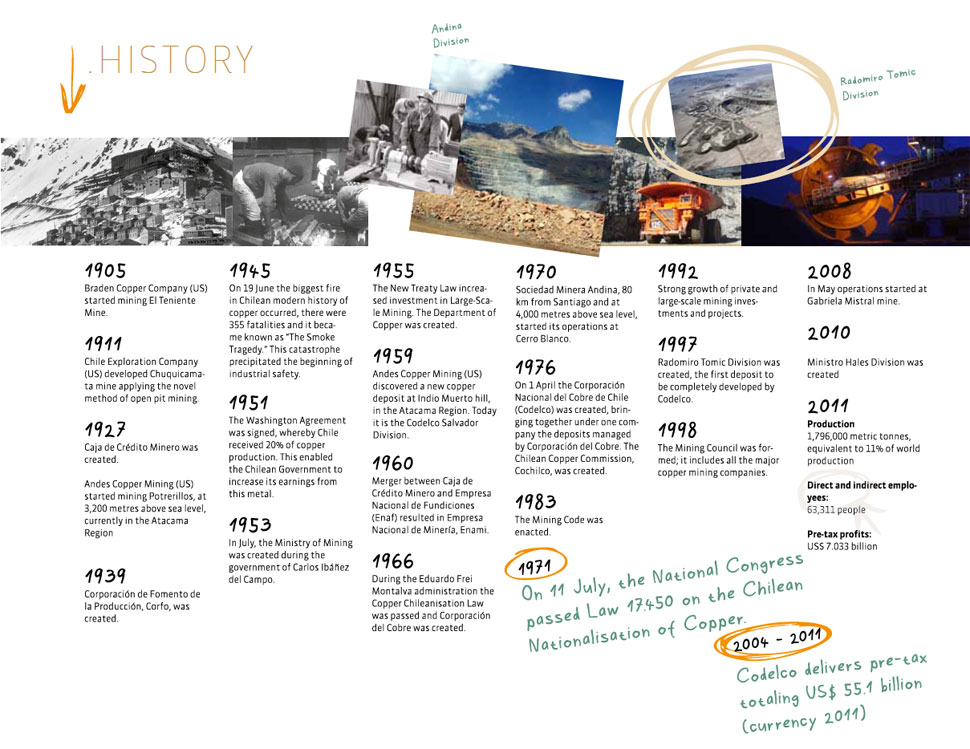
Copper has been one of the pillars of our economic and cultural development since before we were a nation. The indigenous cultures that lived in the Andean region, such as the Incas and Tiahuanacos, Aymaras and Atacameños (Chuquicamata derives from Chukos people), incorporated the red metal to make tools, utensils, and even alloys with other metals which they used as a means of exchange with other neighbouring peoples, and in their various ornamental and artistic expressions, creating part of the symbolic and material universe of these cultures.
The incipient copper metallurgy developed at the beginning of our Pre-Colombian history had a great cultural and economic influence on the Southern Cone, spreading the use of copper and its alloys. Archaeological findings bear witness to the influence of this metal during that period.
When the Spaniards arrived, copper had a strong influence on native South America. The Europeans were more interested in gold than in the red metal. Nevertheless, during the colonial period, there was a small copper industry in Chile. In 1810, the year of our Independence, Chile produced 19,000 tonnes of copper. Between 1820 and 1900, the country produced 2 million tonnes of copper. However, at the end of the 19th century, the nitrate boom monopolised both interest and investors in the mining industry. In 1897, Chile only produced 21,000 tonnes of copper.
At the beginning of the 20th century, American capital was strongly invested in Chile to start mining copper deposits: this was the beginning of Large-Scale Copper Mining in Chile.
El Teniente mine began its operations in 1904 with the American Braden Copper Company, which later became a subsidiary company of Kennecott Copper Corporation. In 1910, Chile Exploration Company started industrial operations at Chuquicamata.
During the 1920s, Andes Copper Mining started operations at Potrerillos mine and then mined the Indio Muerto deposit, at El Salvador ore body.
In 1923, Chile Exploration Company was purchased by Anaconda Copper Company that also controlled Andes Copper, hence Chuquicamata, Potrerillos deposits (today Mina Vieja) and La Africana (in Pudahuel) were under the same management. In 1955, Cerro Corporation conducted studies and subsequently built and mined Cerro Blanco mine, which was opened in 1970 (today Andina Division).
Mining camps emerged around these mining deposits, such as Sewell – declared a Unesco World Heritage Site in 2006 – Coya, Chuquicamata, Potrerillos, Mina Vieja, Llanta and today’s city of El Salvador.
The Chilean State used to receive very little from copper mining until the Washington agreement was signed in 1951. It gave Chile control over 20 percent of copper production, enabling the Chilean government to significantly increase its earnings from copper mining.
As a result of the legislative work in relation to the red metal industry, in 1955 a series of laws were passed in order to guarantee a minimum revenue for the Chilean State, and also to promote the development of the mining industry and capital investment in mining. On 5 May 1955, the Copper Department was created to oversee the national mining industry and to participate in the international red metal markets.
Chilenisation
In the context of the “Chileanisation of Copper”, Law No. 16,425 was issued in 1966 creating joint ventures between the Chilean State and foreign mining companies that mined deposits of what is known as Large- Scale Copper Mining. Legislation set a minimum State interest of 25 percent.
In 1967, El Teniente, Chuquicamata and Salvador mines became joint ventures, and the State acquired a 51% interest. In the case of Exotica and Andina, the State acquired 25%.
Nationalisation
In 1971, the National Congress, through Law 17,450, unanimously amended by Article 10, number 10, of the Chilean Constitution, and the nationalisation of largescale copper mining became a possibility. The same constitutional reform added a temporary provision setting forth that: “as required by national interest and in exercising the State’s inalienable and sovereign interest to freely dispose of its natural resources and wealth, foreign companies involved in Chile’s Large-Scale Copper Mining are nationalised and hence declared to be wholly and exclusively owned by the Nation”.
Hence Large-Scale Mining became wholly owned by the Chilean State. In order to manage these resources state-owned general partnerships were created with the Copper Corporation (95%), formerly the Copper Department, and Empresa Nacional de Minería (5%). The Copper Corporation was in charge of managing these partnerships
Codelco
On 1st April 1976, Corporación Nacional del Cobre de Chile - Codelco Chile - was created. In conformity with Decree Law No. 1,350, Codelco took over the nationalised mining deposits, replacing the State General Partnerships which had been created for this purpose. As a result, the ore deposits at Chuquicamata, Exótica, El Teniente, Salvador and Andina were grouped together to form one mining, industrial and trading company, with legal capacity and equity capital, for an indefinite period of time.
Codelco Chile’s Head Office has been at Huérfanos 1270, its current corporate address, since 1982. The building was previously owned by the Private Employee Savings Bank (Caja de Empleados Particulares).
In relation to new ore deposits, in 1997 operations began at Radomiro Tomic, the first deposit to be completely developed by Codelco. In 2003, Radomiro Tomic and Chuquicamata Division ore deposits and plants formed part of the new Codelco Norte Division.
In January 2005, Codelco acquired Empresa Nacional de Minería, property owned by the Ventanas Refinery – Smelter complex, in the V Region, and it became the new Ventana Division.
In May 2008, the construction stage of the plant and related services were completed, what then was known as the Gaby project, a Codelco wholly owned subsidiary, and the Gabriela Mistral Mine, located in the II Region, approximately 100 km from the city of Calama, began operations. It is the second mine operation completely developed by Codelco from its engineering and construction work to its start-up. It is now Minera Gaby S.p.A.
In 2010, Codelco Norte Division was divided into Chuquicamata Division and Radomiro Tomic Division, in order to focus efforts on the different challenges. During this period, Ministro Hales Division was also created to develop and operate the Ministro Hales mine.
Today, in addition to Head Office and Project Vice- Presidency - a service unit with independent management - Codelco has seven divisions: Chuquicamata, Radomiro Tomic, Ministro Hales, Salvador, Andina, El Teniente and Ventanas, and it also has investments in other deposits. Codelco is the state-owned company

